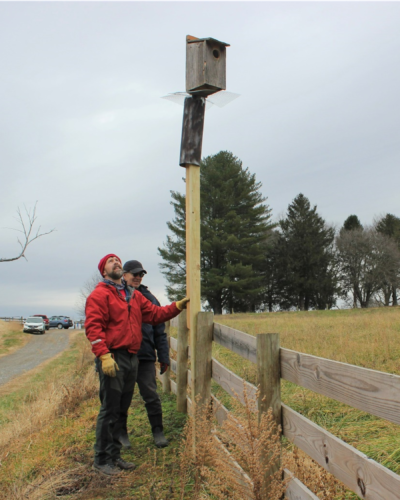Encouraging Wildlife
American Kestrel Nest Box Recommendations
Kestrels are unlikely to nest in a field much less than 20 acres in size. Kestrels will only nest in wide open fields, the more open, the better. They prefer nest boxes at least 200 feet from the nearest wood-line and at least 1/4 of a mile from adjacent boxes. The entrance can face any direction.
Many commercial boxes are not large enough. This one intended for screech owls is a good size: 9.5 ” x 9.5″ x 17″. You can follow Art Gingert’s plans here if you’d like to make your own. These plans include a rim on the bottom of the side panel that will prevent eggs or nestlings from falling out.
Boxes should be approximately 10 feet off the ground. The box should be mounted on the end of a 2″ x 4″ x 12′ pressure treated board. You then screw a 2″ x 4″ x 6′ board to the middle of the first board for additional stability (Alan is holding this board in the photo). The whole setup can then be screwed to a sturdy fence post, with the 6-foot board resting on the top of the fence post (the opposite was done in the photo). A freestanding 6×6 post can be used if there are no fences nearby.
It is important to mount a predator guard below the box. We recommend placing a 2′ x 2′ square of 1/2″ hardware cloth around the pole below the box and attaching a 2-foot-long band of metal flashing below that to make it harder for snakes to get around the hardware cloth. 
You can check your box by using one of these cameras on a pole. If European Starlings try to nest in the box, their nesting material should be removed. If they try to nest repeatedly you can staple a square of cardboard over the hole to keep them from entering the box for the rest of the season.
Managing Land in the Piedmont of Virginia for the Benefit of Birds & Other Wildlife
“The purpose of this guide is to provide landowners with an introduction to land management concepts and conservation tools that can be used to benefit wildlife and counter some of the threats faced by declining bird species.”
Produced by American Bird Conservancy, Piedmont Environmental Council, and Virginia Department of Game & Inland Fisheries.
When to Manage Fields to Minimize Risk to Grassland Birds
A guide to timing field management to avoid peak breeding season, plus a list of grassland birds common to Virginia.
Produced by Virginia Working Landscapes
A Guide To Piedmont Native Plants for Landscaping and Gardens
This document, which was prepared by the Plant Northern Piedmont Natives partnership, provides handy planting recommendations that are tailored for our region.
This resource outlines safe and effective beaver management options for Virginia landowners. Produced by the Clifton Institute, February 2021.

